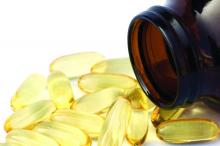in an analysis from a large prospective randomized trial.
Risk reductions on vitamin D in the mixed primary- and secondary-prevention population were slight in absolute terms but reached a significant 19% in the case of myocardial infarction (MI).
Over 5 years, 6.6% of those in placebo group experienced major CV events, the primary endpoint, compared with 6% in the vitamin D group. The difference, which corresponded to 5.8 fewer events per 1,000 participants, was short of significance in adjusted analysis.
Still, vitamin-D supplementation was associated with the potential MI benefit and an 11% drop in risk for coronary revascularization.
Also, a subgroup analysis hinted at a potentially reduced CV-event risk from vitamin-D supplementation among individuals who entered the trial on statins or other CV medications generally.
“Most other studies have not found benefit for vitamin D for major CV events,” senior investigator Rachel E. Neale, PhD, said in an interview. Although there was a significant effect for MI, the difference in the composite primary endpoint fell short of significance “in keeping with the other studies.”
“However, the effects for myocardial infarction in people taking statins or cardiovascular disease drugs at baseline are suggestive of benefit,” said Dr. Neale, of QIMR Berghofer Medical Research Institute, Queensland, Australia. Still, “it is important to keep in mind that these may be chance findings.”
The analysis based on the D-Health study was published online in The BMJ.
Benefits minimal
The 21,302 patients in the D-Health trial, conducted in Australia from 2014 to 2020, were randomly assigned double-blind to receive either placebo or vitamin D3 supplements for a planned 5 years. They were instructed to take one placebo or vitamin D capsule per month, each active capsule containing 60,000 IU of the vitamin.
People with self-reported hypercalcemia, hyperparathyroidism, kidney stones, osteomalacia, or sarcoidosis, and those taking greater than 500 IU/day vitamin D supplements were excluded from enrollment. Participants ranged in age from 60 to 84 at randomization and 46% were women.
With 80% of the 10,658 participants assigned to vitamin D and 78% of the 10,644 control subjects completing the 5-year intervention, 6% and 6.6%, respectively, met the primary endpoint of a major CV event, defined as MI, stroke, or coronary revascularization.
The hazard ratio for a vitamin-D effect on the primary endpoint was 0.91 (95% confidence interval, 0.81-1.01). The number needed to treat to avoid one major CV event was 172.
The HR for MI was 0.81 (95% CI, 0.67-0.98), for coronary intervention was 0.89 (0.78-1.01), and for stroke was 0.99 (0.80-1.23).
Adverse event rates were similar at about 16% in both groups and included hypercalcemia, kidney stones, gastrointestinal issues, and skin rash.
Vitamin D at moderate dosages has low toxicity, Dr. Neale said, “so I think it would be reasonable for clinicians to consider supplementing elderly people who do not have contraindications, particularly those who have underlying risk factors for CV disease,” Dr. Neale said. But patients should be told that the evidence for such a recommendation is not strong, so they can make an informed decision, she added.
Also, in general “we would be cautious about extrapolating to formulations other than those used in the study,” Dr. Neale said. “However, in this case, I think it would be reasonable to extrapolate to the use of 2,000 IU per day taken orally, provided that the same adherence can be maintained for a lengthy period.”


